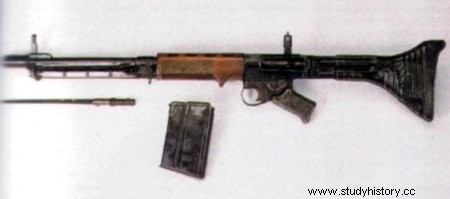
* Caliber:7.92×57mm
* Length:93.7cm (F); 106.6cm(G)
* Barrel length:50.8cm (F); 52.5cm (L)
* Unladen weight:4.38kg (F); 5.05kg (G)
* Rate of fire:900 rounds/minute (F); 600
strokes/minute (G)
* Capacity:10 and 20 round magazines
The Fallschirmjägergewehr 42, better known by its nomenclature code FG-42, is a submachine gun that was exclusively designed for the German airborne troops, the Fallschirmjäger, during World War II. This weapon, comparable to the American Browning BAR M1918 submachine gun, was distinguished by its lower weight and its use:it was directly intended for combat as the main weapon, whereas the BAR was a support weapon.
The objective was to compensate for the small numbers of paratroopers by nature deployed in enemy territory with superior firepower. The Luftwaffe had expressly requested the use of the 7.92 x 57 mm, a rifle ammunition also used on the K 98k while the manufacturers would have preferred the 7.92 mm Kurz whose lower power seemed better suited to automatic fire. Too light for a machine gun, the FG-42 suffered significantly from the defect of machine guns:its automatic fire was uncontrollable even with the bipod due to excessive recoil and its magazines only offered 20 shots. This weapon, which was also expensive to produce, was only copied after the war for the Saco M60 machine gun, which was also far from being a technical success.
Equipped with a magazine placed on the side, a bipod and a folding fixed bayonet under the barrel, two versions were produced. The F model that appeared in 1942 was relatively light and had a higher rate of fire. Its bipod fixed in front of the guard, its shoulder stock was made of stamped metal and its handle had a very important angle to facilitate the shooting towards the ground during the descent by parachute. The G model intended to make up for the shortcomings of the first model was heavier and its rate of fire was reduced. Equipped with a wooden stock, a bipod fixed to the end of the barrel and longer by 25mm and its grip was conventional. However, these modifications were not sufficient to resolve its shortcomings.
The use of this weapon makes it the very first assault rifle, yet technically it remains a submachine gun and will ultimately very poorly fulfill the function assigned to it. It is for this reason that the Sturmgewehr 44 is rather considered the first assault rifle worthy of the name and the FG-42 rather constituting an ancestor of this type of weapon.
